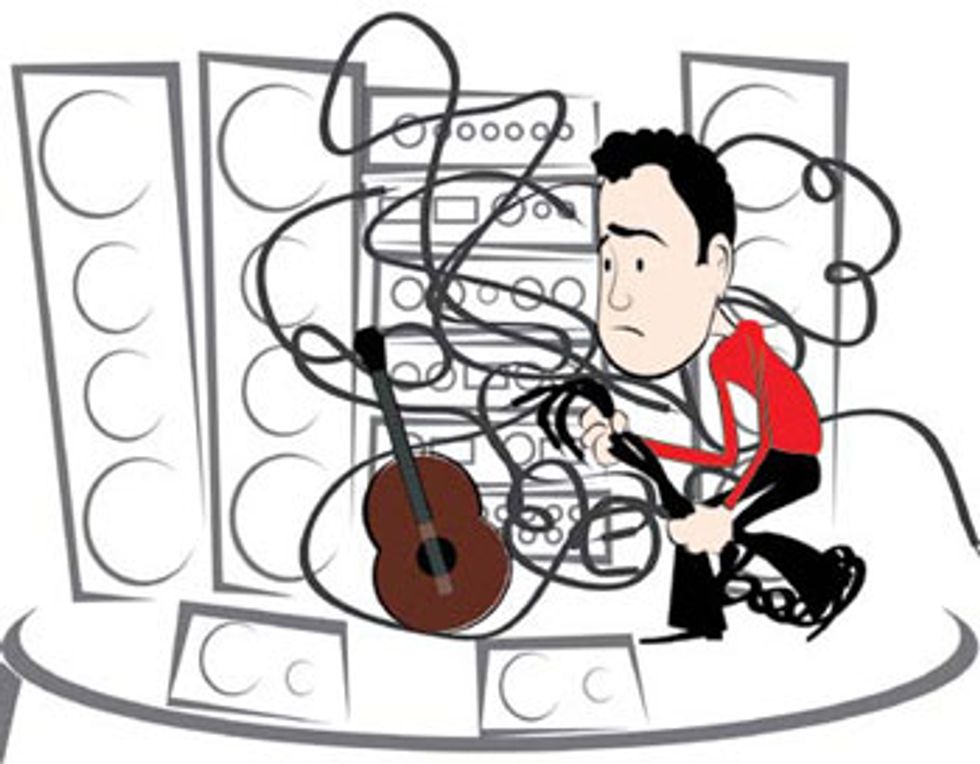By now you may be thinking, “What is this story doing in a column about acoustic amplification?” It has everything to do with understanding and choosing the right gear for the job.
 If you’ve ever played an amplified acoustic onstage—especially when
you have to set up the gear yourself and deal with a rowdy crowd—you
know the feeling of being caught in a maze of wires, knobs, and mics.
And feedback lurks everywhere. What to do—buy a Strat and a Deluxe?
Fortunately, gear exists to solve virtually any acoustic amplification
problem. The key is to take the time to study the issues and options.
If you’ve ever played an amplified acoustic onstage—especially when
you have to set up the gear yourself and deal with a rowdy crowd—you
know the feeling of being caught in a maze of wires, knobs, and mics.
And feedback lurks everywhere. What to do—buy a Strat and a Deluxe?
Fortunately, gear exists to solve virtually any acoustic amplification
problem. The key is to take the time to study the issues and options.Congratulations! Your solo gig at the coffeehouse went really well. With the help of family and friends, you managed to fill the room and the audience loved your performance. The room’s acoustics were friendly and your mic’d guitar was just right for the setting. As a bonus, an old college buddy happened to be in the audience that night, and you had a nice time catching up with each other’s lives. It turns out your buddy just happens to be the manager of a brewpub that recently opened in town, and he wants you to host an acoustic, open-mic night there every Friday—starting next weekend.
Wow, a steady gig! You happily accept the offer and agree to stop by the pub the following night, check out the scene, and go over the details of the gig. But when you show up at the pub at 6:00 the next day, you get the sudden feeling of stepping off the edge of a cliff. The place is huge! It holds more than 300 people and is already packed, full of customers washing away their workday stress with mugs of suds and plates of spicy wings and nachos. You notice four or five widescreen plasmas over the bar and the AC is chilling the whole place to meat-locker-like temperature levels.
You connect with your friend and he gives you the quick tour. The stage—slightly elevated and carpeted—is in the corner of the room and it looks like it could comfortably hold about six musicians. To the left of the stage are a series of windows that are about 12' tall, and the ceiling is about 20' high with exposed beams and metal ducting. To the right of the stage (and within earshot) is the end of the bar and server station—plenty of activity and noise here. There is a decent set of large, powered PA cabs on either side of the stage, no floor monitors, and a new 24-channel mixer. The manager explains he’d like you to perform solo for the entire first set, and then for the following three, open with one solo number and then coordinate the guest musicians in both solo performances and group jams. Because the manager has to run, he says good-bye and that he’ll see you on Friday, but not before mentioning that his roommate Charlie—who serves shots at Starbucks during the day, but is “really into music”—will be running the PA during the gig.
You jump into your car, pop in your favorite Leo Kottke CD, and head for home. You’re still excited about the gig, but very apprehensive about the playing environment. While you’re not really a gear guy, you are smart enough to realize that the boom-mic setup that worked so well last week in the coffeehouse just won’t cut it at the pub.
When you drive by the shop that sold you your last guitar—you see that they are still open and decide to drop in and discuss the situation with the owner. While the shop is acoustic-oriented and full of great guitars, it only has a few, used acoustic amps that were taken in trade. Sympathetic to your situation, he suggests that you go talk to “Stevie,” who runs the acoustic department at a larger store nearby, is really into gear, and an easy guy to deal with. So you buy a few sets of strings and a handful of fingerpicks, thank the owner for his advice, and head across town to see Stevie and shop around a bit.
As it turns out, Stevie is just the right guy to talk to because he gets it immediately. You’re primarily a fingerstyle player (not a three-chord basher) and you play some pretty complicated material with lots of dynamics. You need to be able to maintain a light touch and feel comfortable and in control of your instrument. In addition to playing solo, you will be jamming with groups during the open-mic sessions, so you will definitely need a system that cuts well in the mix. You will also be performing in a fairly raucous environment with some very unfriendly room acoustics. The reflectiveness of the large windows will bounce the sound all over the stage and the tall ceiling is likely to create standing waves that will promote feedback and boominess.
These issues, along with having to deal with an inexperienced soundman and the distraction of having to cater to and coordinate the guest musicians, means that you will need amplification gear that is straightforward and simple to set up. At the same time, your gear should be fully featured and include the necessary tools needed to overcome bad acoustics and allow you to get a great sound—both onstage and throughout the room.
By now you may be thinking, “What is this story doing in a column about acoustic amplification?” It has everything to do with understanding and choosing the right gear for the job. Say your ’91 Subaru Outback stops running on the way home from a gig, and you need two 13 mm box wrenches to tighten the alternator belt. Well, that full set of Craftsman SAE tools that your wife bought you for Christmas—while shiny and new—is totally useless. Context is everything!
Next time, we’ll look at the gear you ultimately chose and how it worked out on the gig.
 Larry Fishman holds
more than 30 patents in
transducer and musical
instrument design. He is
president and founder
of Fishman Transducers,
which he began in his
garage in 1981. In the early ’90s, he
also co-founded and managed Parker
Guitars (which was later sold to U.S.
Music Corp.) with his friend Ken Parker.
Larry Fishman holds
more than 30 patents in
transducer and musical
instrument design. He is
president and founder
of Fishman Transducers,
which he began in his
garage in 1981. In the early ’90s, he
also co-founded and managed Parker
Guitars (which was later sold to U.S.
Music Corp.) with his friend Ken Parker.

